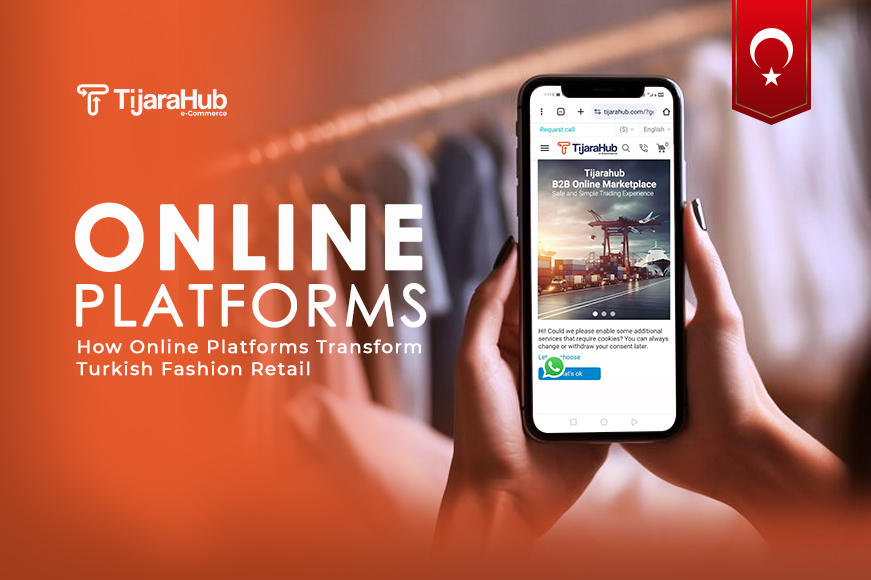How Online Platforms Transform Turkish Fashion Retail

In the vibrant world of Turkish fashion, a significant transformation is underway, driven by the relentless force of online platforms. As technology continues to reshape the way we shop and interact, Turkish fashion entrepreneurs are navigating this digital revolution to unlock new avenues of growth. This blog explores the multifaceted impact of online platforms on Turkish fashion retail, delving into crucial aspects from e-commerce trends to visual merchandising strategies and future technological advancements.
Discover how these changes influence how consumers "buy Turkish clothes online," shaping the industry's landscape and propelling it into a dynamic era of digital commerce.
The Digital Revolution in Turkish Fashion
The Rise of E-commerce
The emergence of e-commerce has been a game-changer for Turkish fashion. Traditional brick-and-mortar stores are now supplemented, if not replaced, by online counterparts. The convenience of browsing and buying from the comfort of one's home has reshaped the consumer landscape, offering a diverse array of choices at the click of a button.
Impact on Traditional Retail
This shift has inevitably impacted traditional retail, prompting store owners to reconsider their strategies. Many have embraced the dual approach of maintaining physical stores while bolstering their online presence, striking a delicate balance between the tangible and the digital.
Changing Consumer Behavior
Consumer behavior is evolving, with an increasing reliance on digital platforms for fashion exploration. The younger demographic, in particular, prefers the convenience and accessibility of online shopping, accelerating the pace of change within the industry.
Navigating the E-Commerce Landscape
Key Online Platforms in Turkish Fashion
Navigating the e-commerce landscape involves understanding and harnessing the power of critical online platforms. From established marketplaces to dedicated fashion e-commerce websites, Turkish entrepreneurs have many options to showcase their products and reach a global audience.
Choosing the Right E-Commerce Model
Choosing a suitable e-commerce model is a critical decision that can significantly impact the success and growth of a Turkish fashion business online. This decision involves considering various factors, including the brand's identity, target audience, and growth objectives. Here's a detailed explanation of how to make the right choice:
Understand Your Brand's Identity:
- Brand Image and Values: Consider the values and image your brand wants to convey. If you have a unique and well-defined brand identity, setting up an independent online store may allow you more control over the branding and customer experience.
- Product Range and Specialization: If your brand specializes in a niche or unique product range, an independent online store can showcase your offerings without distraction. This model allows you to create a tailored experience that aligns with your brand's identity.
Analyze Your Target Audience:
- Demographics and Preferences: Understand your target audience's demographics and preferences. If your audience is tech-savvy and prefers a wide range of products, partnering with established e-commerce platforms might provide exposure to a larger customer base.
- Behavioral Patterns: Analyze the online shopping behavior of your target audience. Do they frequently browse through popular online marketplaces, or are they more likely to explore dedicated websites? This insight will help you choose a model that aligns with your audience's preferences.
Evaluate Growth Objectives:
- Market Expansion: If your growth objectives include reaching a wider audience and expanding into new markets quickly, partnering with established e-commerce platforms can offer immediate visibility and access to a broad customer base.
- Brand Control and Long-Term Goals: If maintaining control over your brand's image and customer experience is a priority, investing in an independent online store allows for greater customization. This model may be more suitable for brands with long-term goals and a desire to build a loyal customer base.
Consider Budget and Resources:
- Initial Investment: Evaluate your budget for launching and maintaining an online presence. Setting up an independent online store may require a higher initial investment for website development, marketing, and maintenance.
- Operational Resources: Consider the resources available for managing daily operations. Partnering with established e-commerce platforms often streamlines operations as they handle payment processing, logistics, and customer service.
Explore Hybrid Models:
- Combining Approaches: Some brands find success in adopting a hybrid approach. This involves having an independent online store for brand building and customer engagement while leveraging the reach of established e-commerce platforms to tap into a broader audience.
- Multi-Channel Selling: Explore multi-channel selling strategies, where your products are available on your independent store and popular e-commerce platforms. This approach allows for diversification and increased visibilit.
Building a Strong Online Presence
Building a robust online presence goes beyond listing products. It involves crafting a compelling brand story, optimizing for search engines, and utilizing digital marketing strategies to drive traffic. An effective online presence is not just a virtual storefront but a dynamic platform for engagement.
The Power of Visual Merchandising Online
Creating Stunning Product Imagery
Visual appeal is paramount in the digital realm. High-quality, captivating product imagery is the currency of online fashion. Brands invest in professional photography and styling to showcase their products in the best light, enticing customers with visuals that speak louder than words.
Virtual Storefronts: Design and User Experience
Virtual storefronts' design and user experience are pivotal in retaining customers. Intuitive navigation, aesthetically pleasing layouts, and a seamless checkout process contribute to a positive online shopping experience, fostering customer loyalty in the virtual world.
Utilizing Social Media for Visual Marketing
Social media has emerged as a powerful tool for visual marketing in Turkish fashion. Platforms like Instagram and Pinterest are not just places to share images but dynamic spaces for storytelling and brand promotion. Successful brands leverage these platforms to connect with their audience on a personal level.
Enhanced Customer Engagement Strategies
Personalized Shopping Experiences
Personalization is the cornerstone of customer engagement. Turkish fashion retailers employ data-driven insights to offer personalized recommendations, discounts, and exclusive experiences, making customers feel seen and valued.
Leveraging Customer Feedback
Customer feedback is a goldmine of insights. Actively seeking and responding to feedback builds trust and allows businesses to refine their offerings continually. Reviews and testimonials contribute to the brand's credibility, influencing potential customers.
Implementing AI and Chatbots
The integration of artificial intelligence (AI) and chatbots enhances customer engagement. AI-driven chatbots provide instant assistance, streamline the shopping process, and contribute to a seamless customer experience. From answering queries to suggesting products, these technologies elevate the level of service.
Overcoming Challenges in Online Turkish Fashion Retail
Cultural Considerations and Sensitivity
Operating in the digital space requires a nuanced understanding of cultural considerations. Brands must navigate cultural sensitivities to avoid inadvertently causing offense or misunderstanding, a challenge unique to the diverse landscape of Turkish fashion.
Addressing Language Barriers
Language barriers can pose a challenge in reaching a global audience. Offering multilingual support online, from product descriptions to customer service, ensures effective communication and broadens the brand's appeal.
Adapting to Local Payment Preferences
Adapting to local payment preferences is essential for online Turkish fashion retail success. Offering various payment options, including those preferred regionally, enhances the customer experience and fosters trust.
Future Trends in Turkish Fashion E-Commerce
Technological Advancements on the Horizon
The future of Turkish fashion e-commerce holds exciting technological advancements. From augmented reality (AR) fitting rooms to virtual fashion shows, brands are poised to leverage cutting-edge technology to create immersive and interactive customer experiences.
The Role of AR and VR in Online Fashion
AR and VR are set to revolutionize online fashion retail by providing virtual try-on experiences and immersive shopping environments. These technologies bridge the gap between the physical and digital worlds, offering a new dimension to online fashion exploration.
Sustainable Practices in Digital Retail
Sustainability is not just a trend; it's a necessity. The future of Turkish fashion e-commerce involves a commitment to eco-friendly practices, from sustainable sourcing to eco-conscious packaging. Consumers increasingly prioritize brands that align with their values, including a commitment to environmental responsibility.
Conclusion
Transforming Turkish fashion retail through online platforms like Tijarahub is a dynamic journey. With the help of our service, buyers and certified producers may easily conduct transactions. This gives customers a hassle-free shopping experience while increasing manufacturers' market share.
For those seeking the latest trends and styles, the convenience of Turkish women's clothing shops online adds an extra layer of accessibility, underscoring the profound impact of these digital shifts on both businesses and consumers alike.










